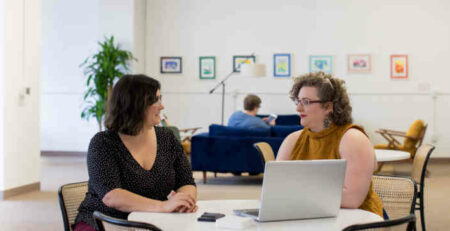How Remote Work is Changing the Way We Hire Creatives in 2020
COVID-19 fundamentally changed the way people relate to the work they do. For creatives, many tools of the trade were already digital, so when companies suddenly had to rely on remote work from home to stay afloat, creatives were in a more fortunate position than other hands-on industries. But just like creatives have had to reorient their roles around services like Skype, Zoom, and Slack, so too have the businesses that rely on creative talent had to come up with creative ways to keep productivity up and communication easy for their teams.
Creative staffing agencies have had to adjust to the new realities of 2020 as well. At icreatives, we already had plenty of experience with sourcing talent and vetting top candidates with digital tools. We’ve increasingly had to rely on these tools, but that’s not the only way the Black Swan events of early 2020 have changed the way we go about hiring talent.
Traditional offices rely on person-to-person contact to delegate and complete tasks. There is a certain amount of incidental chance that often plays a part in creating solutions. For instance, two employees who don’t work in the same department might run into one another in the break room and start to chat. In the course of the conversation, they could think up a solution to a challenging situation thanks to the additional perspective.
It takes imagination to use online meetings and conference calls to enable this same possibility in 2020. Creatives are often just the kind of employees who can think up unique individual solutions, and that’s one of the considerations that became more important when hiring talent this year.
Many supervisors and managers dread remote work, believing it reduces their ability to exercise control over teams as their job description requires. Although remote work from home has been a niche trend since internet technology made it possible in the 90s and early naughts, it was an emergency necessity beginning in the early months of 2020. Many managers have been panicking and using rushed, half-baked methods to try and shoehorn traditional management methods into the new remote work structure.
This can damage credibility and undermine the position of management and the company itself. Remote work and schedule flexibility are two of the best employee retention strategies, but if management doesn’t approach the new remote work challenge in the right way, they could well turn a golden opportunity into a major blunder.
Remote work from home or even from a long-distance locale is the signature imprint 2020 left on hiring talent for the creative industry. It arrived with no bellwether, but many companies have been able to adapt. Read on to find out how remote work changed the way icreatives has been hiring talent in 2020 for a better understanding of remote work and how businesses are turning this year’s insanity into a huge plus.
Remote Work Structures for Creative Jobs
Whether it was a cautionary choice by management or a response to lockdown measures, businesses in every industry had to invent new procedures and systems to continue operations in the digital sphere almost overnight. With little to no warning, trial and error have played a big role in this process.
However, because every company had to start reorganizing from the ground up, the results have been varied. There are many lessons to take from this year’s shift to remote work.
One of the central communication methods used for remote work is the conference call. Platforms like Skype and Zoom enable workers to communicate by video and shared workspaces like Google Docs keep collaboration possible in the digital sphere.
Knowledge and skill with cutting edge technology was always a primary factor when hiring talent, but these new structures have made it even more crucial. The number of new remote jobs has thrown a wrench in the hiring process of many hiring managers, but in many ways, icreatives’ method of hiring talent proved to be perfectly adaptable.

Remote Work Trends for 2020
Huge social networking companies like Facebook and Twitter have already announced that remote work from home is unlikely to go anywhere even after COVID-19 becomes a thing of the past. Morgan Stanley saw 90% of its workforce moved to remote work during the pandemic and envisions work from home (WFH) playing a huge role in the job market for at least the next 3 to 5 years.
Trends show that the vast majority of company founders are reaping the benefits of implementing WFH structures. Many say they wouldn’t return their WFH employees to traditional office-based positions even if social distancing and stay-at-home orders were lifted. A large part of this reasoning has to do with the immense cost of renting or maintaining huge office buildings. Plus, surveys have been showing schedule flexibility and remote work options are favorite perks for employees in every industry since the 90s. Many workers say they would start looking for work elsewhere if their current company ended remote work options.
The general trend in 2020 seems to be that remote work isn’t going anywhere, but many managers and owners learned that that isn’t nearly as scary as they thought it would be. Productivity is the same or even better at the majority of companies that implemented remote work strategies successfully. That has implications for creative talent, as well.
Creative Jobs & Remote Work
When we speak about remote work, the image of the digital nomad comes to mind for many people. Expats or long-term travelers who live in a remote paradise and do all their work from a laptop do exist, but they are far from the only people who use remote work to their advantage.
For all jobs, remote work generally allows for a better work-life balance. Trends show that employees take fewer sick days and are more active when they’re on the clock when they do remote work from home.
The danger of remote work for creative positions is that some companies relied too heavily on the freelancing experiences that many creatives have from the early days of their career. Framing work for a company too much like freelance gigging may lead to an estranged relationship between the company and creative workers. It’s certainly not a promising employee retention strategy.
Creative jobs like design and content writing can easily be done anywhere there’s a computer and strong wi-fi. Allowing creatives the space to mold their remote work positions into what they want it to be will go a long way in keeping them happy, but management also needs to exercise some control to make sure things are getting done.
How to Conduct an Online Interview
Hiring managers were tearing their hair out at the beginning of 2020 because their most trusted method – the interview – was essentially impossible. Skype interviews have been used by some companies for years, but they do lack the direct interaction and atmosphere of in-person meetings and interviews. There are a few strategies you can use to make online interviews more effective and still get a good idea of what a given job candidate is like.
- Take It Easy
One of the most obvious results of the remote work revolution is that people are now fulfilling professional roles without the professional dress code. Now, thankfully there is still some semblance of a dress code in the digital workspace. People aren’t generally hopping online shirtless or disheveled, but they are dressing in a more relaxed manner overall. Managers and interviewers should adjust their approach to interviews accordingly.
That doesn’t mean you should crack open a cold one and chat about football during an interview, but adopting a more relaxed stance and a conversational tone will make the candidate feel more at ease and likely get better – and more honest – responses.
Interviews done with a video service or conference call app allow for a more intimate look into people’s lives. The 2020 interview frequently features a cat jumping into frame or even a small child. Participants also get a small glimpse into the homes of whoever they’re talking to on a video call. Use these details to your advantage to break the ice.
- Set Clear Parameters
Although making the interviewee more at ease is a great strategy, you still need to elicit the right kind of information. Since the interview is happening via computer, the candidate can more easily show parts of a portfolio or study case with screen sharing or hyperlinks. However, asking for such things during an interview will derail the proceedings if you haven’t asked the candidate to prepare the materials ahead of time.
Let them know everything you want to see and ask them to have it ready to send your way during the interview. You can even ask for it ahead of time so you can look it over and think of some relevant questions.
Setting clear parameters also means setting a definite time. Even though remote work is generally more relaxed, there should be some sense of a time structure. This can be decided with the candidate, but it should still be clearly determined.
- Make Eye Contact with the Candidate
Conducting an interview online too often makes real eye contact impossible because the camera is just above the screen. However, you should still take care to look at the candidate and not spend time typing or reading information on screen. As much as possible, have the video feed on the top of your windows and pay attention to voice cues and facial expressions just like you would in an in-person conversation.
Failing to do so will make the interview boring and stilted, leading to more reserved responses and making a negative impression more likely. While the platform does limit much of the body language we use when we meet someone face to face, there are still plenty of ways to make video calls more like in-person conversations. Eye contact is one of the best ones.
You should also take care to let the candidate know you’re listening. While the majority of the time should be given to them to answer questions and give you an impression of their professional capabilities, make sure to insert the occasional head nod or affirmative so they know you’re following along with them. Showing you’re engaged will likely make the candidate more engaged, too.
7 Qualities to Look for in WFH Employees
1- Self-Motivation
Is this candidate going to keep being productive without a manager just down the hall? Will somebody have to keep tabs on them and waste time on calls to reprimand them or keep them on task? One of the most important factors to consider is the way a creative motivates themself to finish a task. Self-driven people are not only easier to manage but often more dedicated to the job in general.
2- Tech Savvy
The wide range of digital tools used to accomplish creative tasks ballooned even before 2020 tossed the process for hiring talent on its head. The ideal candidates should always be on the cutting edge and be interested in continuing education so they always know the best and most effective way to get the job done.
3- Communication Skills
Personability should translate across digital platforms. Whether it’s through text in a group chat or a video or conference call, the best creatives should know how to explain what they’re doing. This goes triple for creatives working at a primarily non-creative business. Clear communication can also make digital meetings more interesting and, best of all, make them shorter.
4- Delegation & Independence
These two qualities may not sound like they go together, but delegating tasks and receiving delegated tasks requires a large amount of independence. Some people are overburdening coworkers with additional tasks because they don’t see their coworkers working all day at work anymore. An independent candidate will also speak up when their plate is too full, ensuring the task can be done by someone less busy and not be stuck on the back burner for too long.
5- Trustworthiness
Of all the qualities, dependability is always going to be one of the most important things to look for in a worker whether they do remote work or traditional office-based work. Trusting employees to accomplish tasks and not spend all their time browsing the internet instead of working is the cornerstone of employment in general, and it’s even more important with remote work from home.
6- Collaborative
The only way sporadic solutions can be found when everyone is communicating digitally is for employees to have a sense of collaboration. People who take advantage of group chats and use creative tools like digital polls will usually come up with far more imaginative solutions in the workplace, whether it’s digital or not. Look for someone who can clearly state the problem and probe for solutions to make collaboration easier among coworkers.
7- Time Management
Save managers time by hiring someone who knows how to prioritize tasks and accomplish everything on time. It will reduce ‘babysitting’ tasks which will make coworkers and management much happier. Even better if the candidate knows how to organize tasks at a team level and knows how to draw up schedules and timetables for the people they work with directly.

Creative Staffing Agencies and Remote Work
At icreatives, we’ve carefully considered remote work from all sides and tailored our hiring process to meet the new normal. Knowing what to look for when hiring talent is key, and our vast experience with creatives has allowed us to keep finding the best creatives even when interviews and the larger vetting process moved entirely online.
With the new vault to remote work, creative staffing agencies will save companies even more time and money. There’s no need to retrain hiring managers on new platforms or rely on their ability to effectively use digital tools. We’ve already made that transition at icreatives. All you need to do is reach out and we’re happy to use our experience to help your company.
Conclusion:
2020 will go down as a critical turning point in world history. Creative industries were very much affected by the events of this year, and savvy staffing agencies knew exactly how to adjust. Some of the qualities a creative needs to work well changed somewhat, but the key qualities are still the same.
No doubt meeting in-person still plays a part in business and our lives more broadly. The social aspect can lead to innovative solutions and creates a more engaging workplace. But for now, remote work still seems like it will be the norm in creative industries well into 2021. Luckily, icreatives has already adjusted to that new reality and we’re still here to help you fill open positions with the best creative talent there is.












